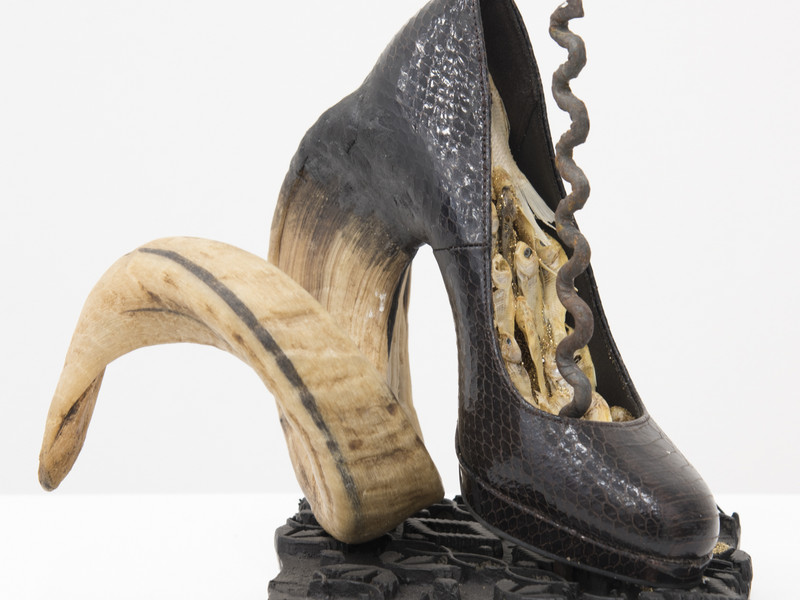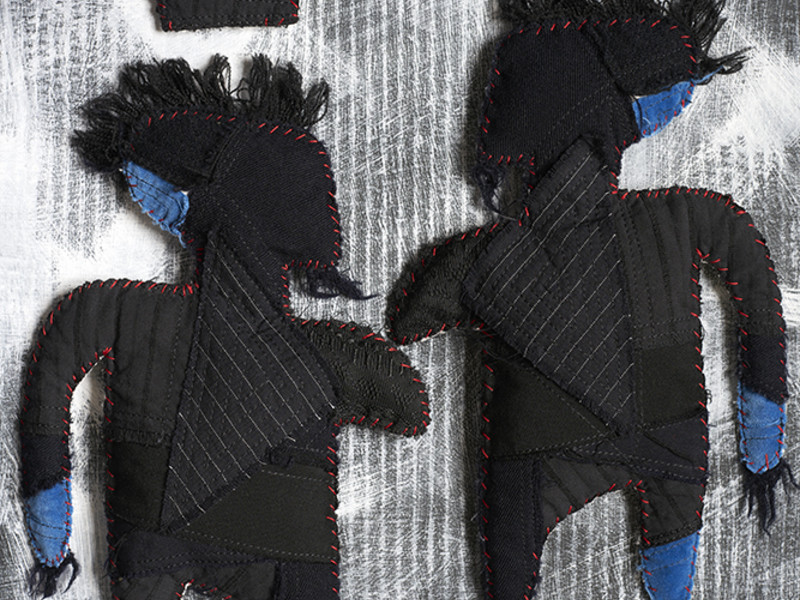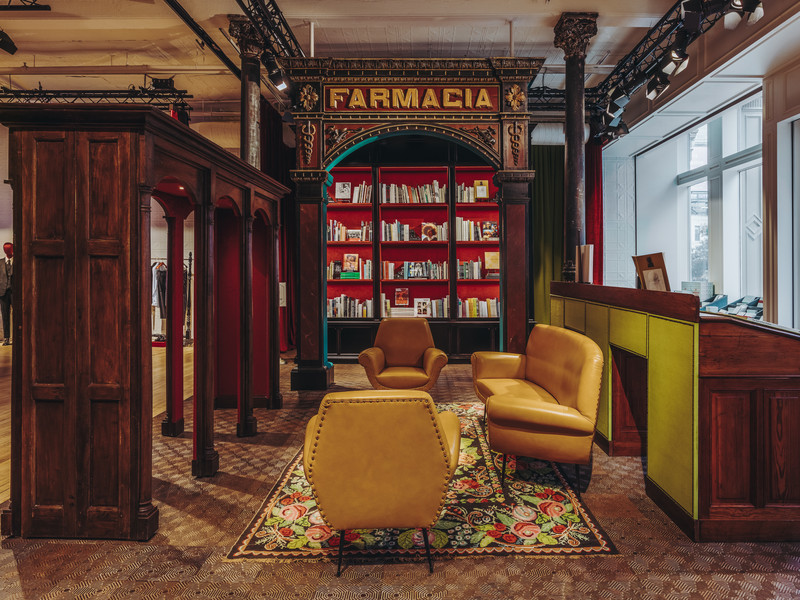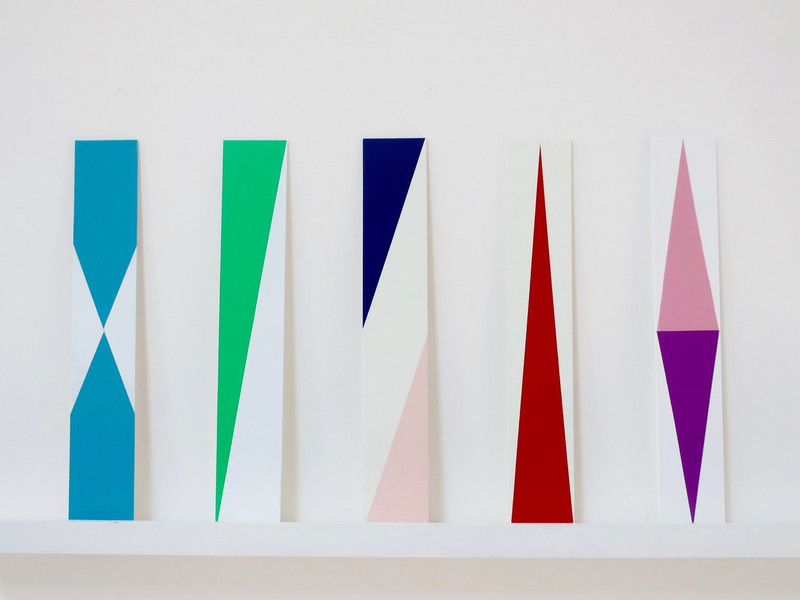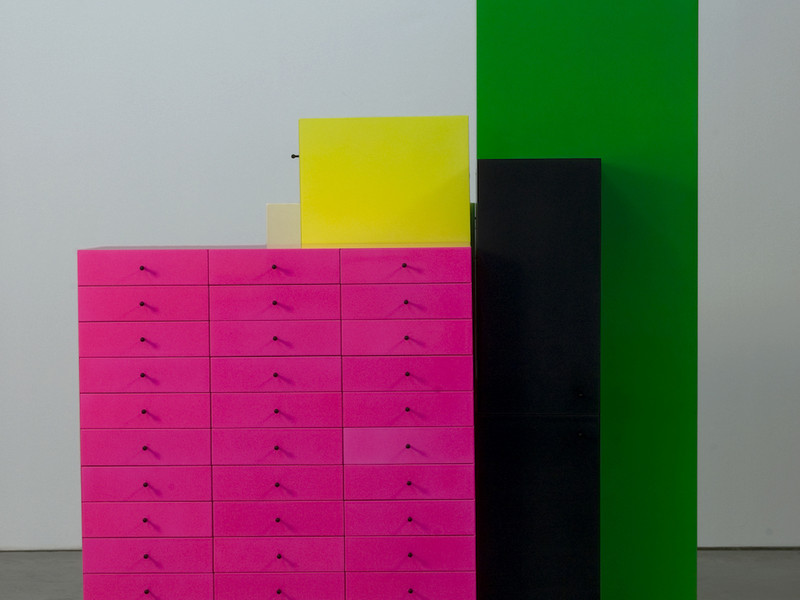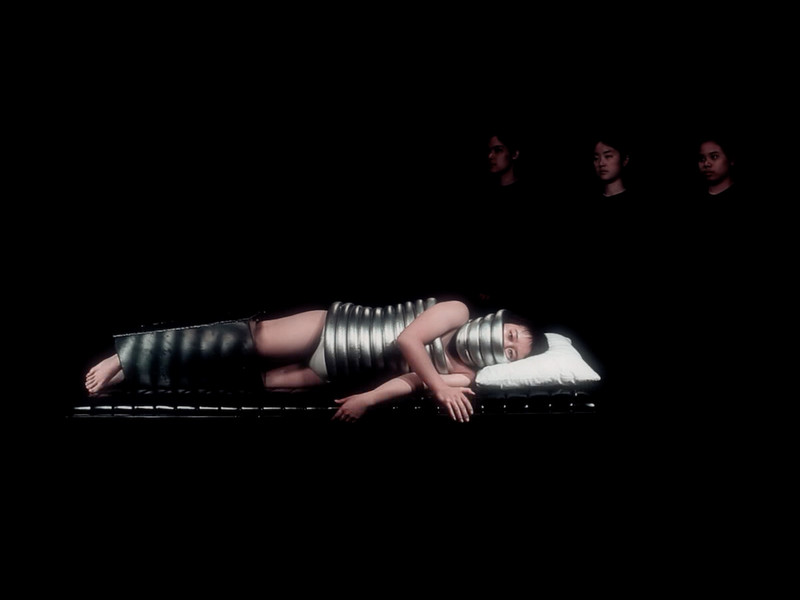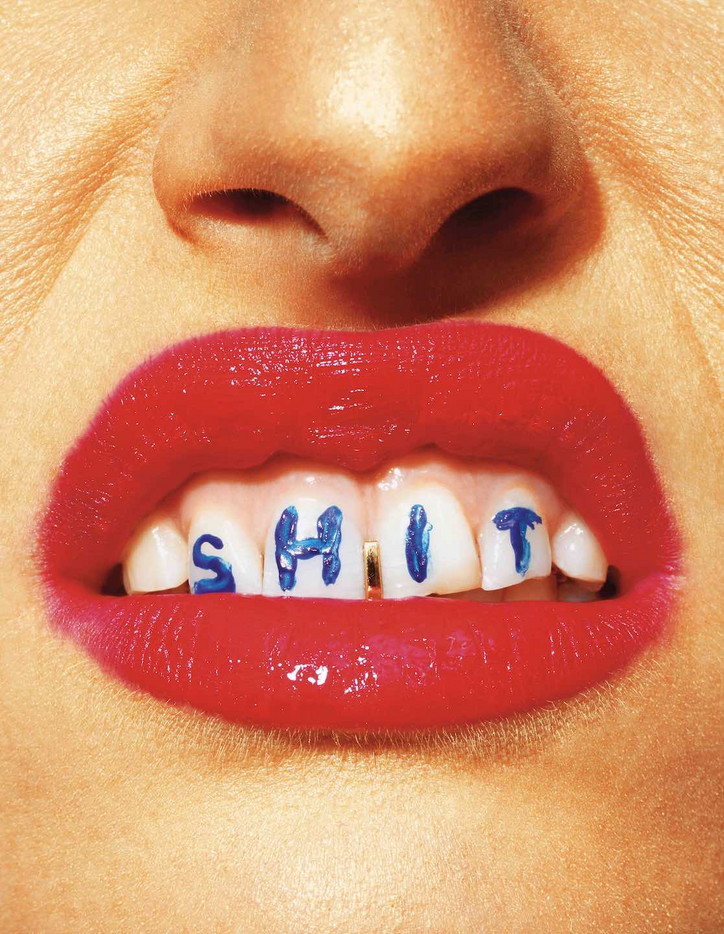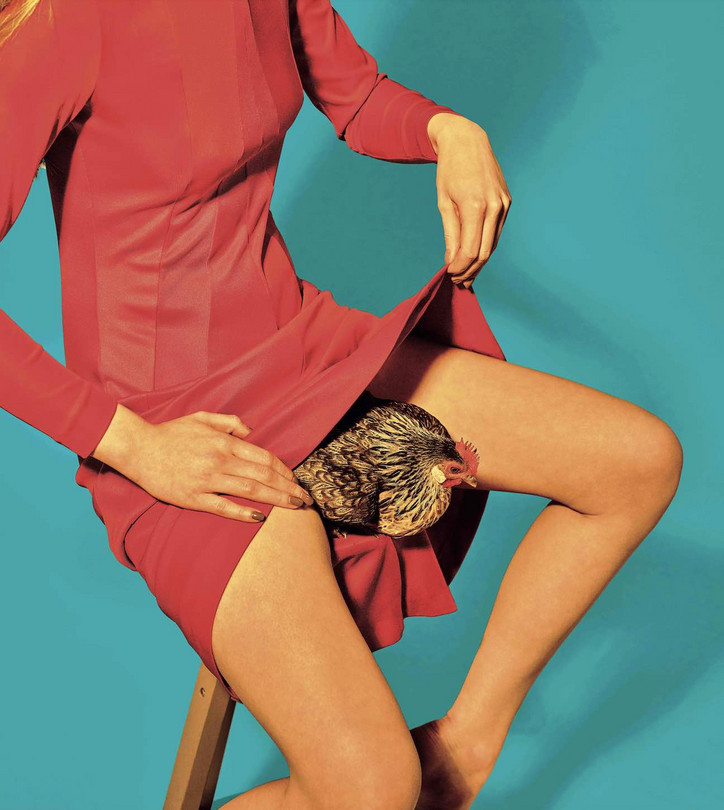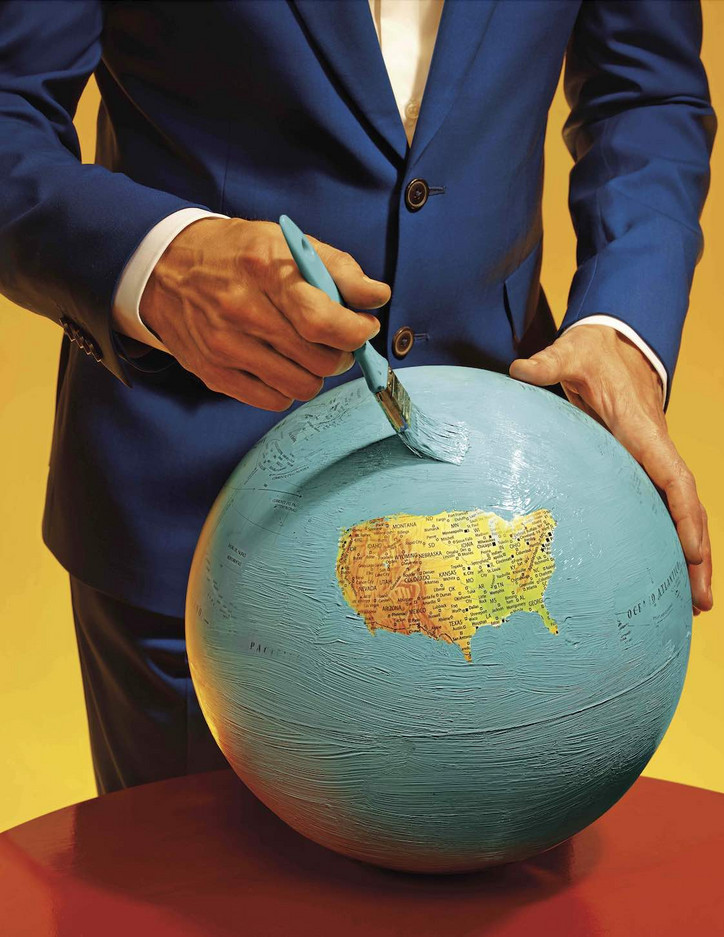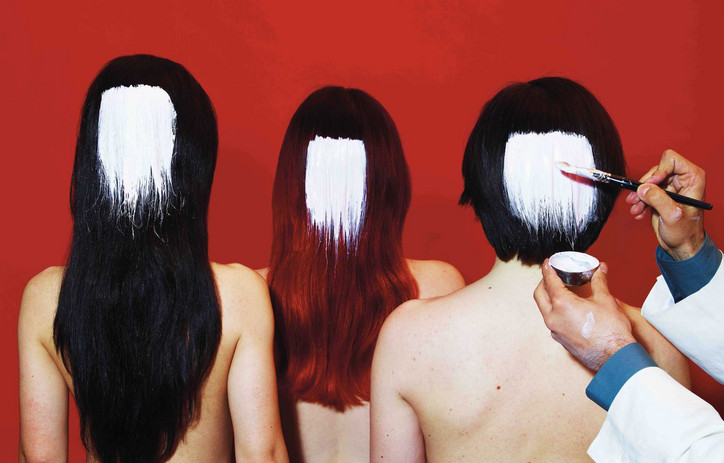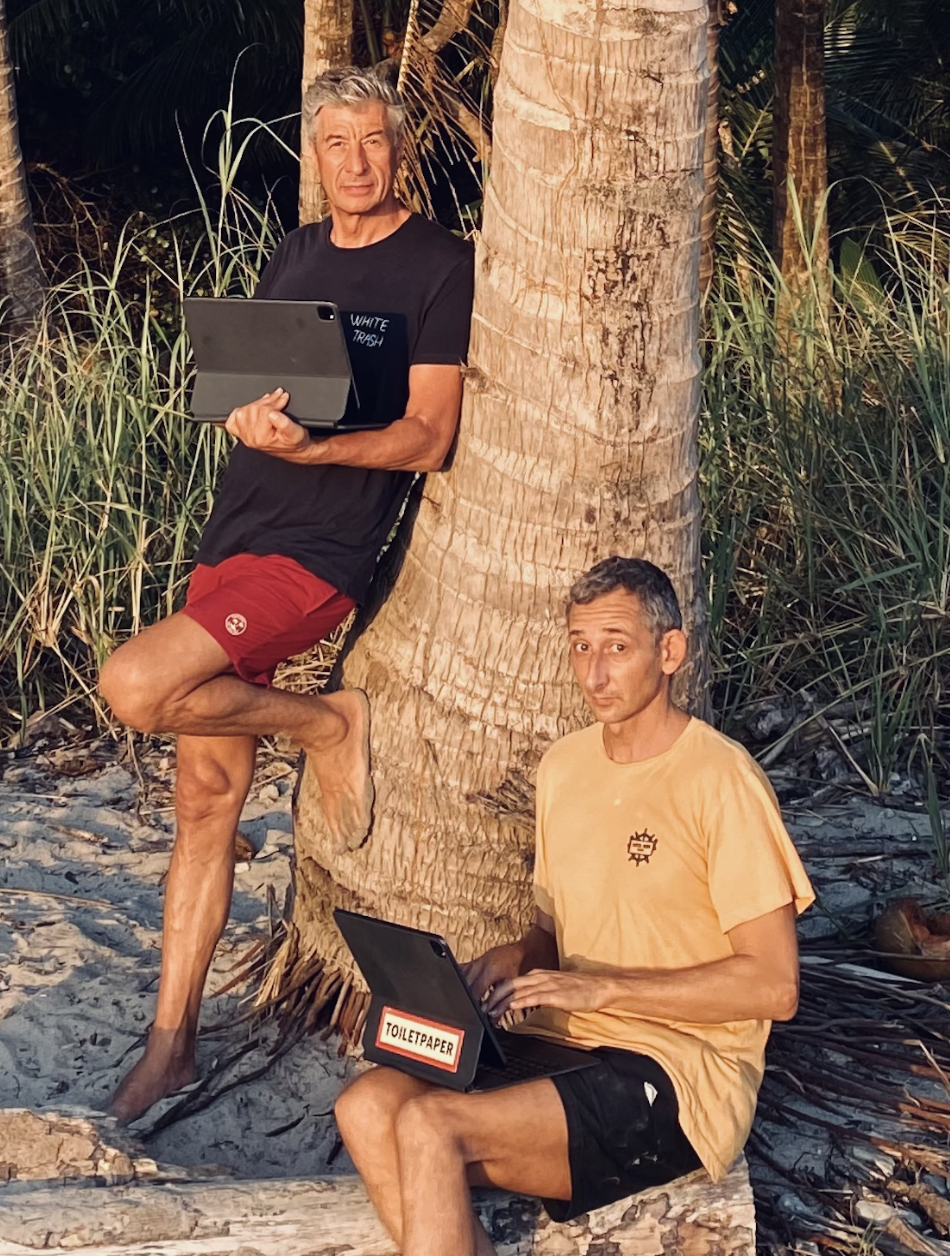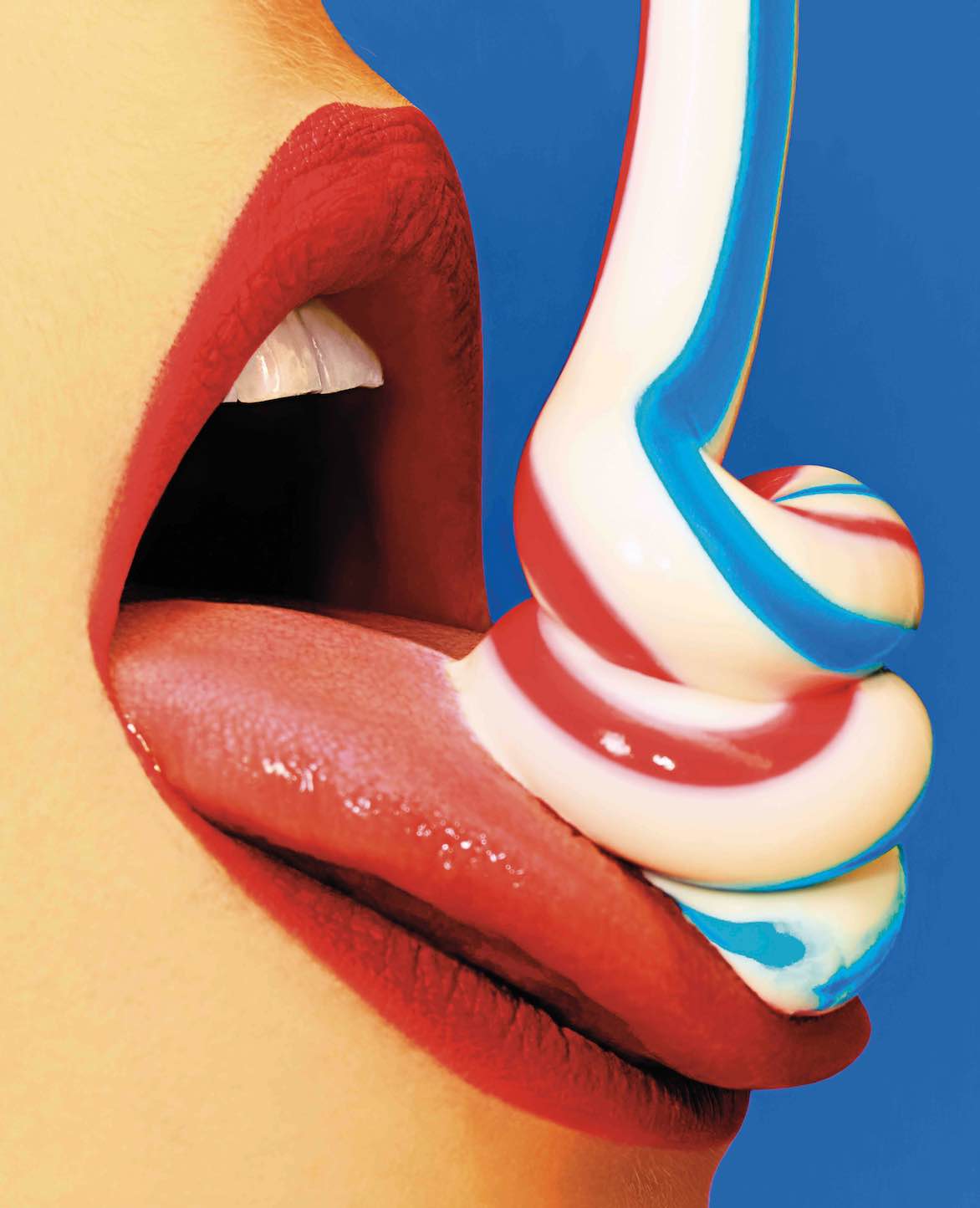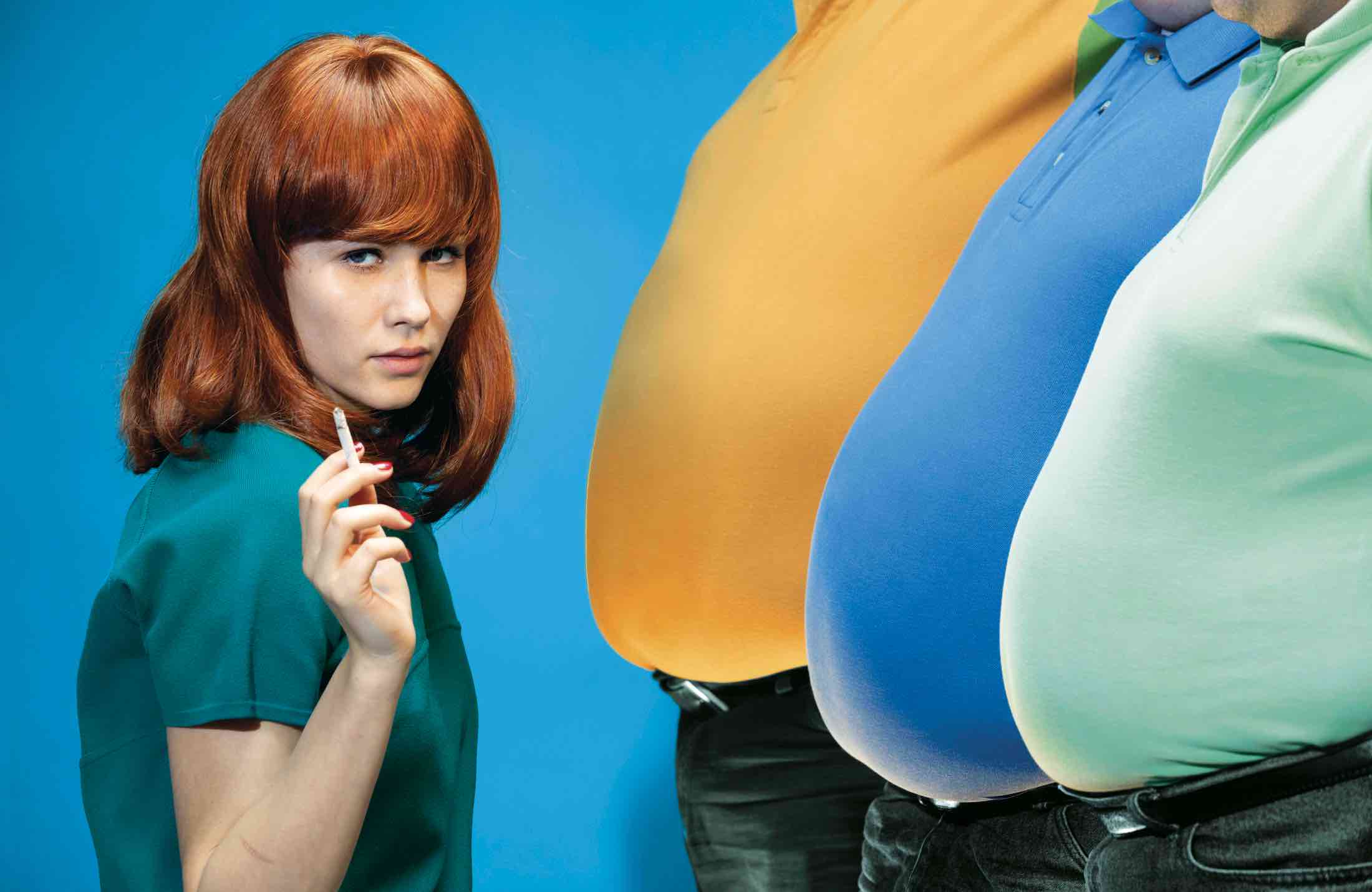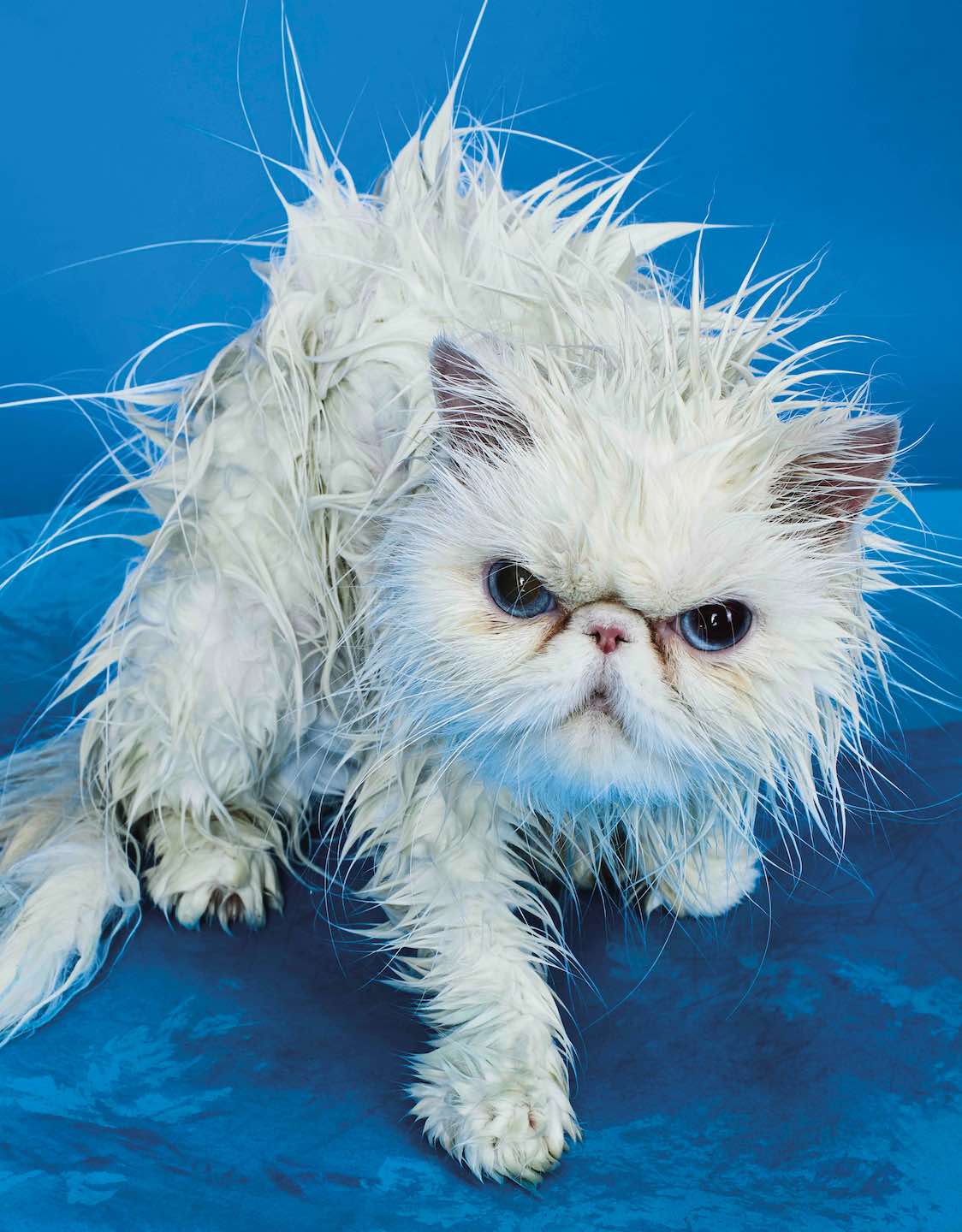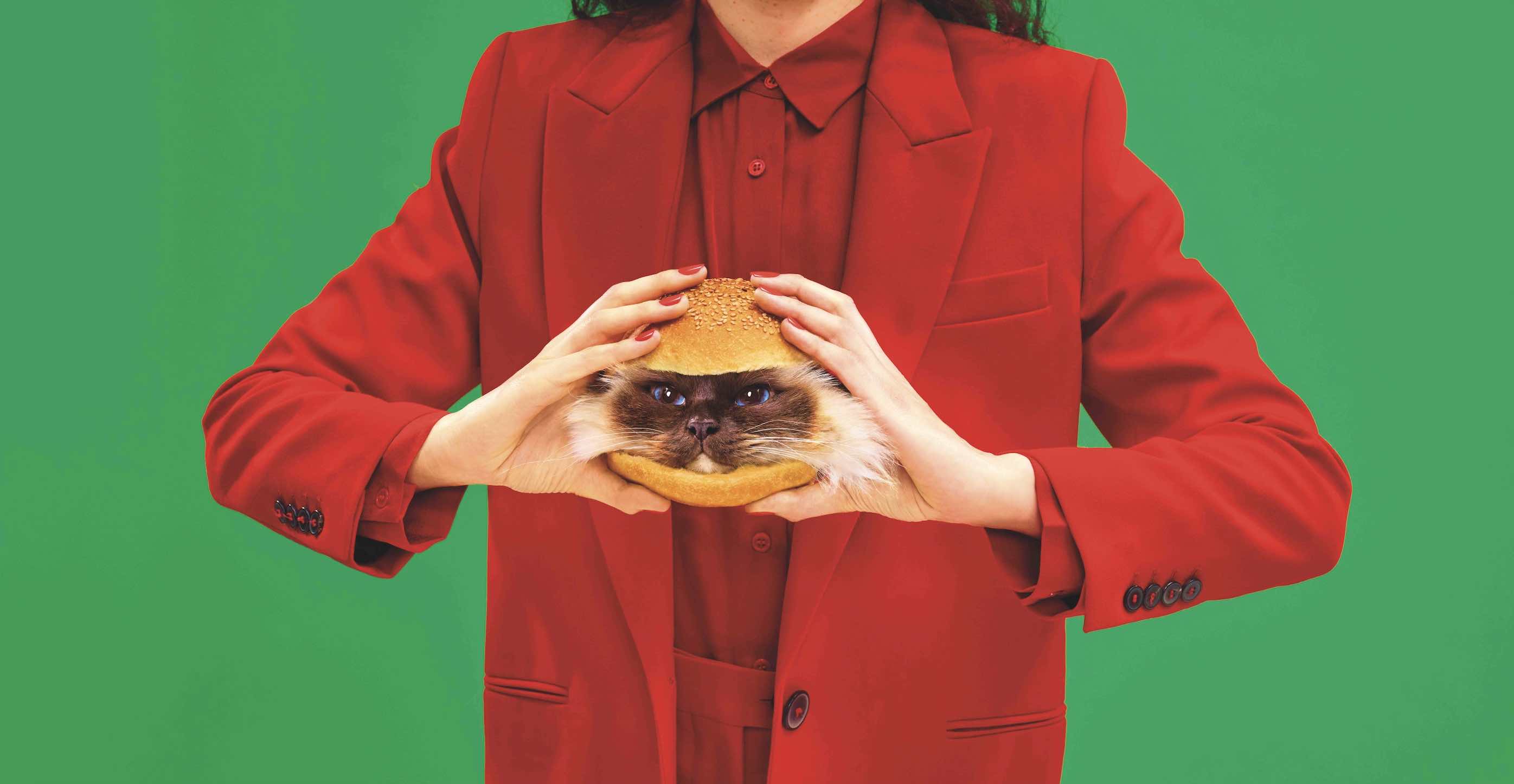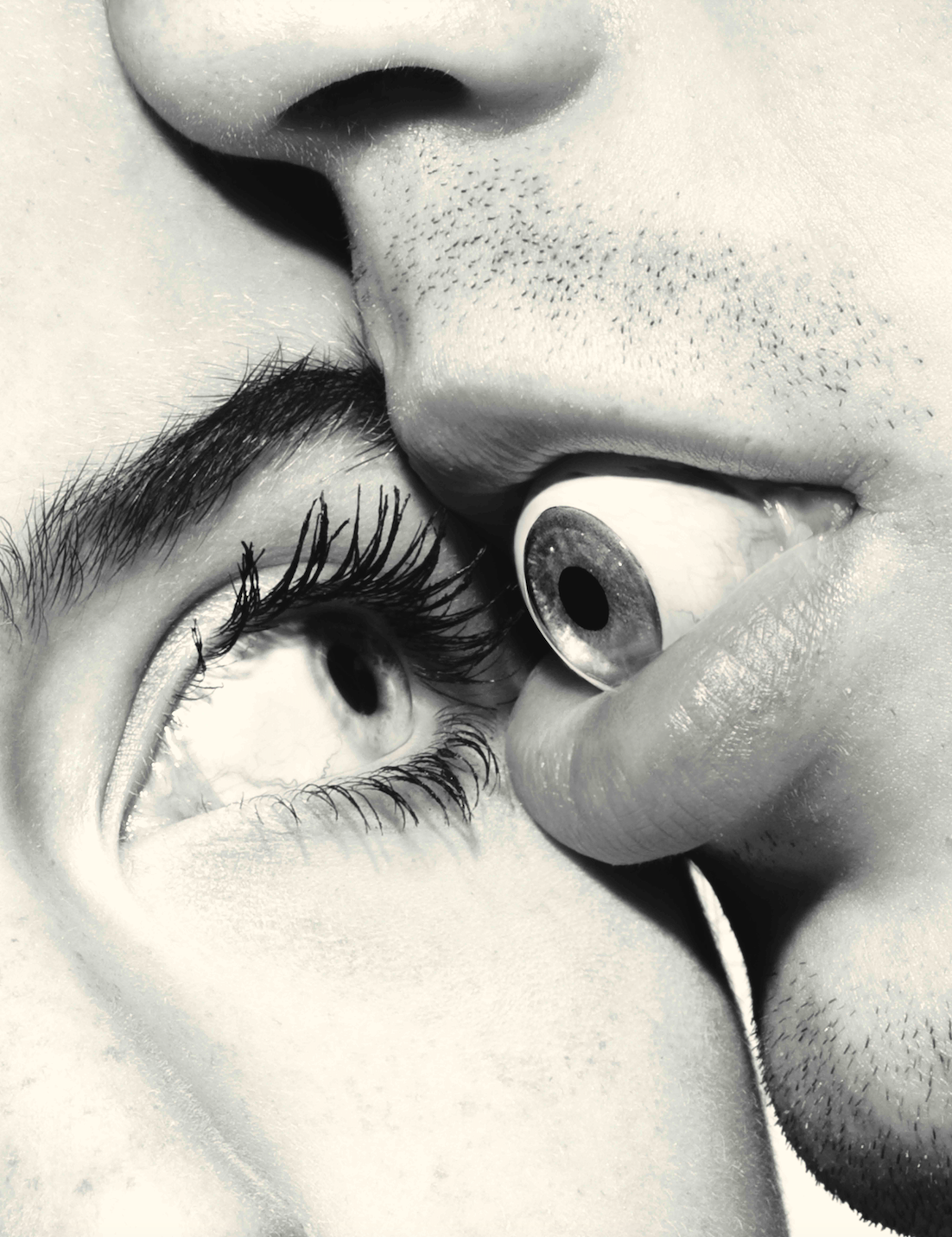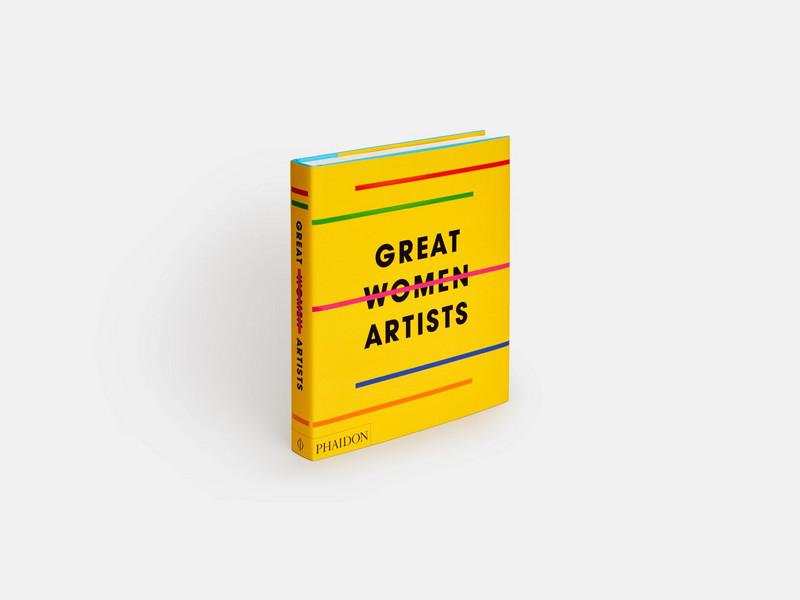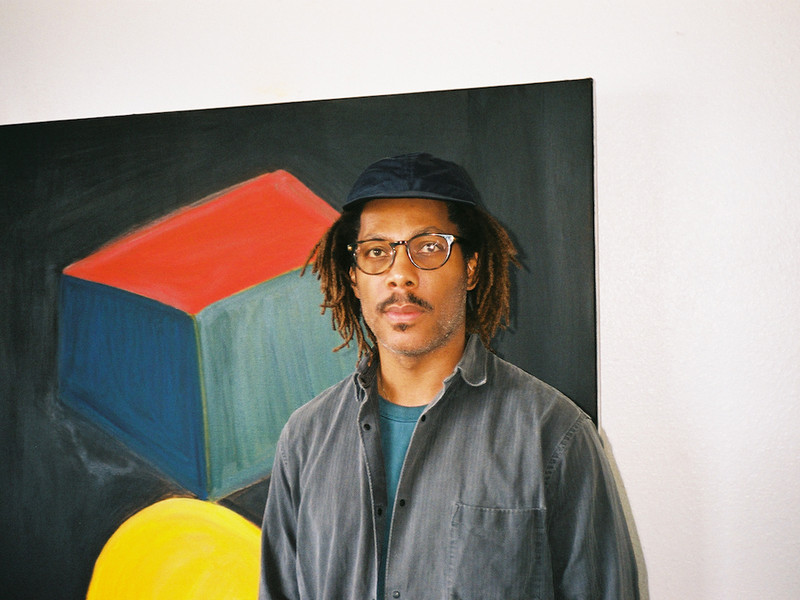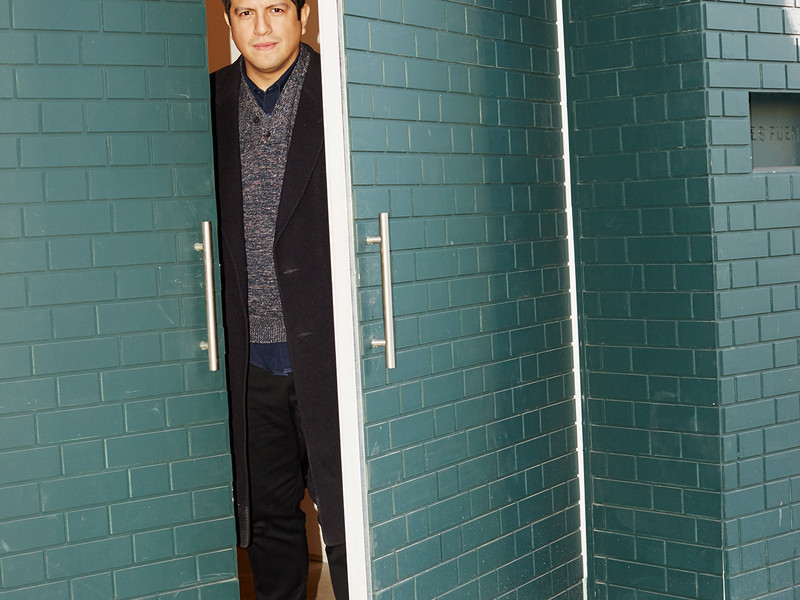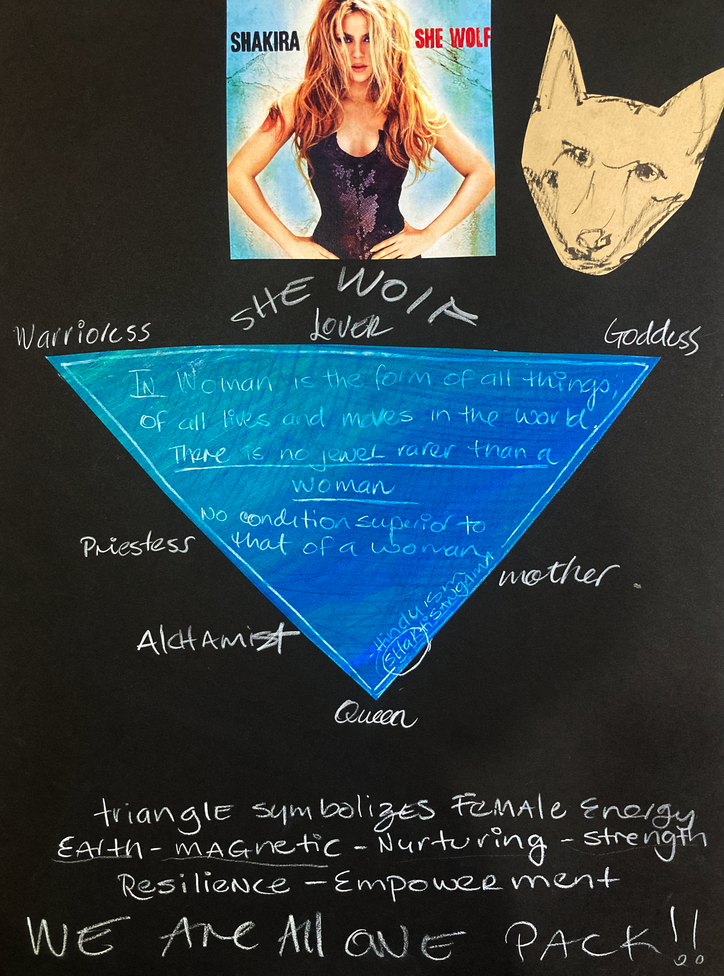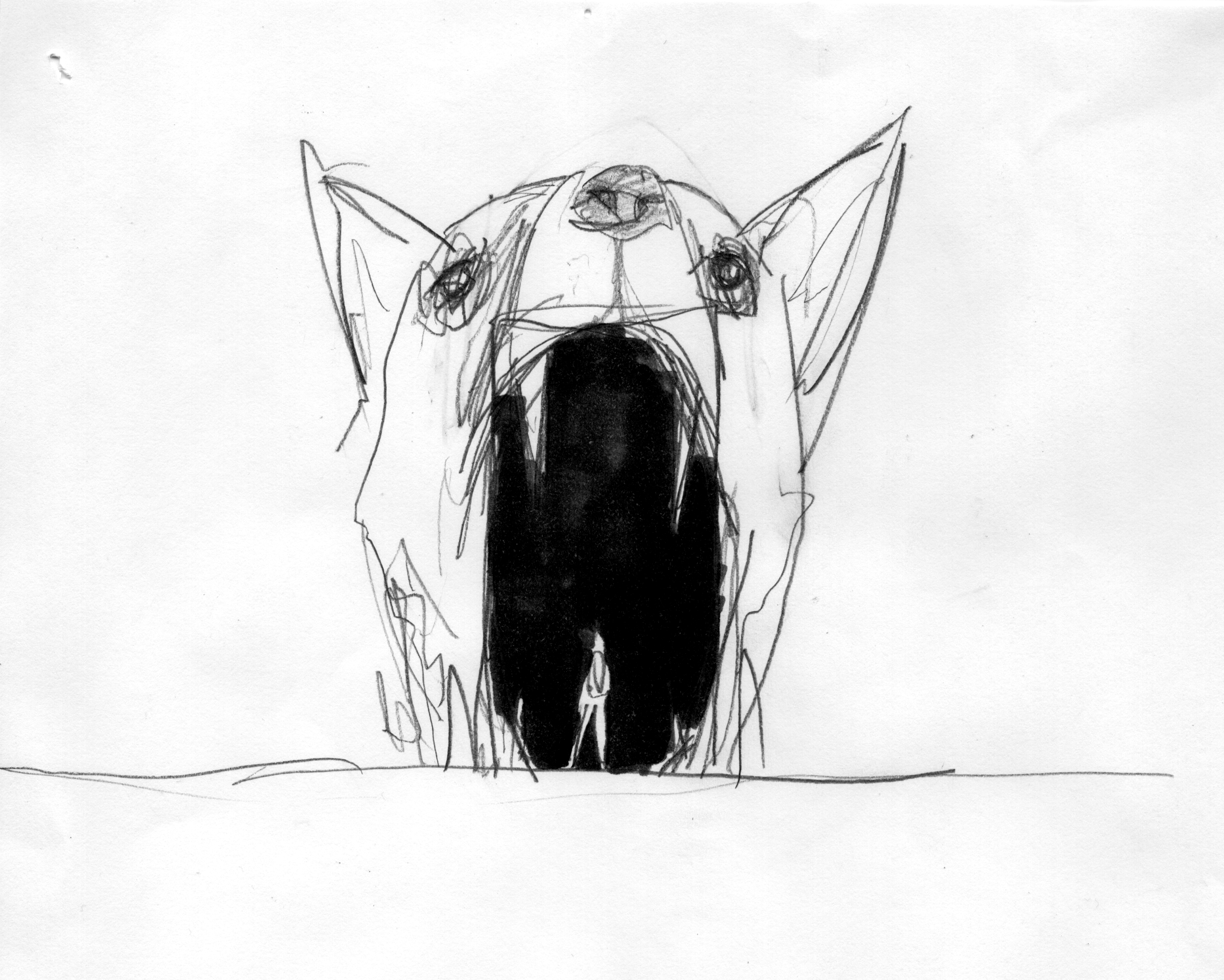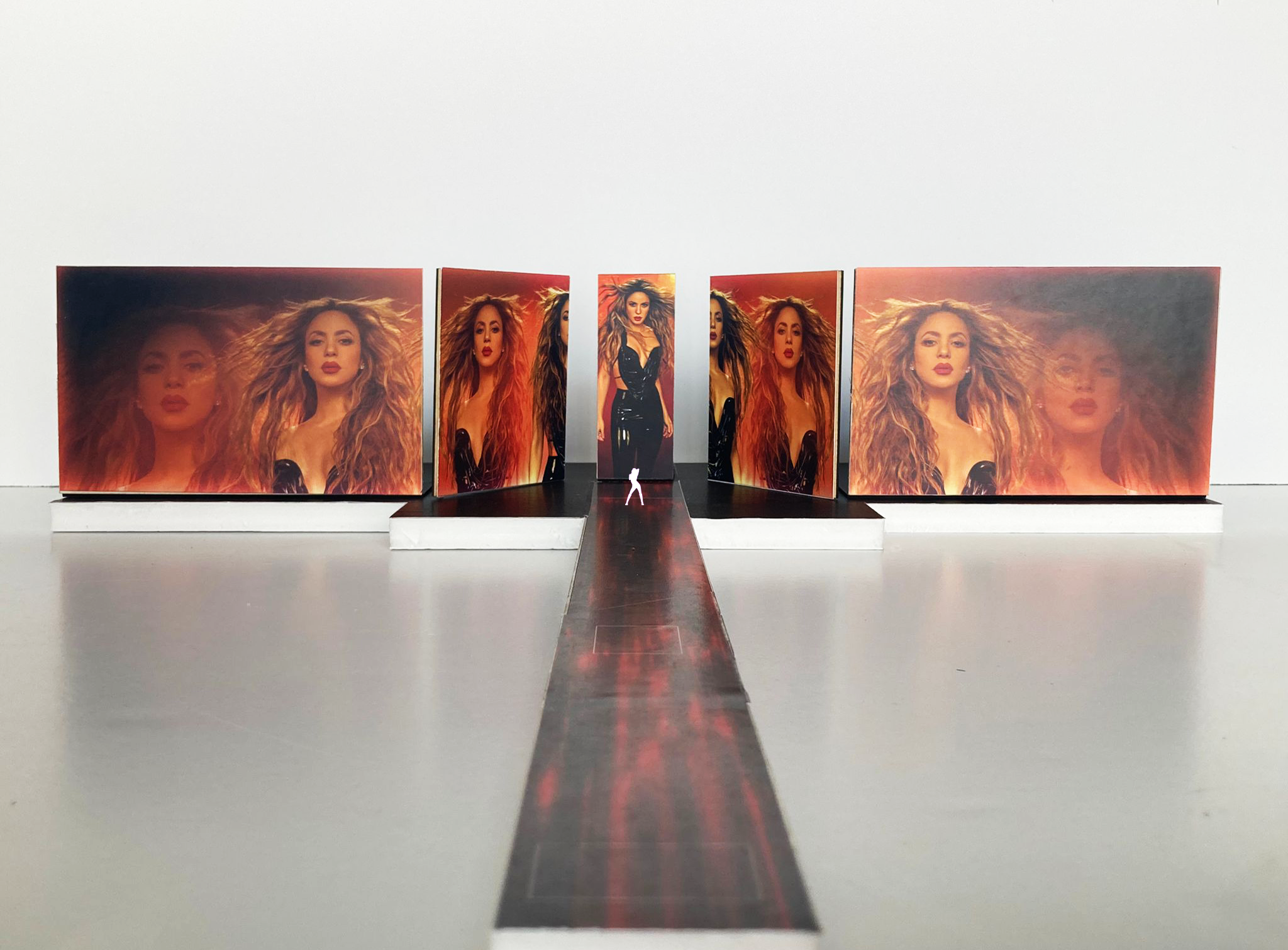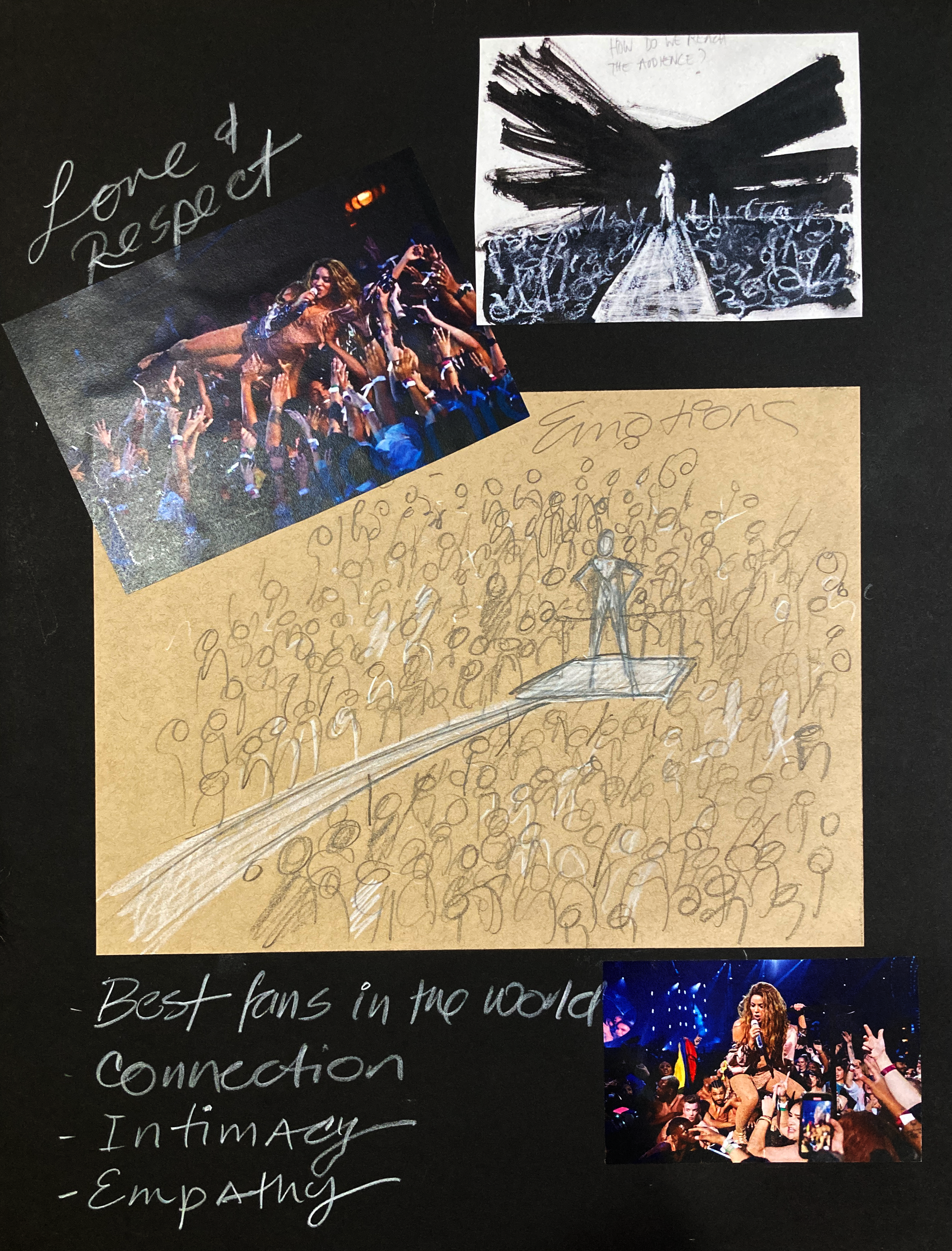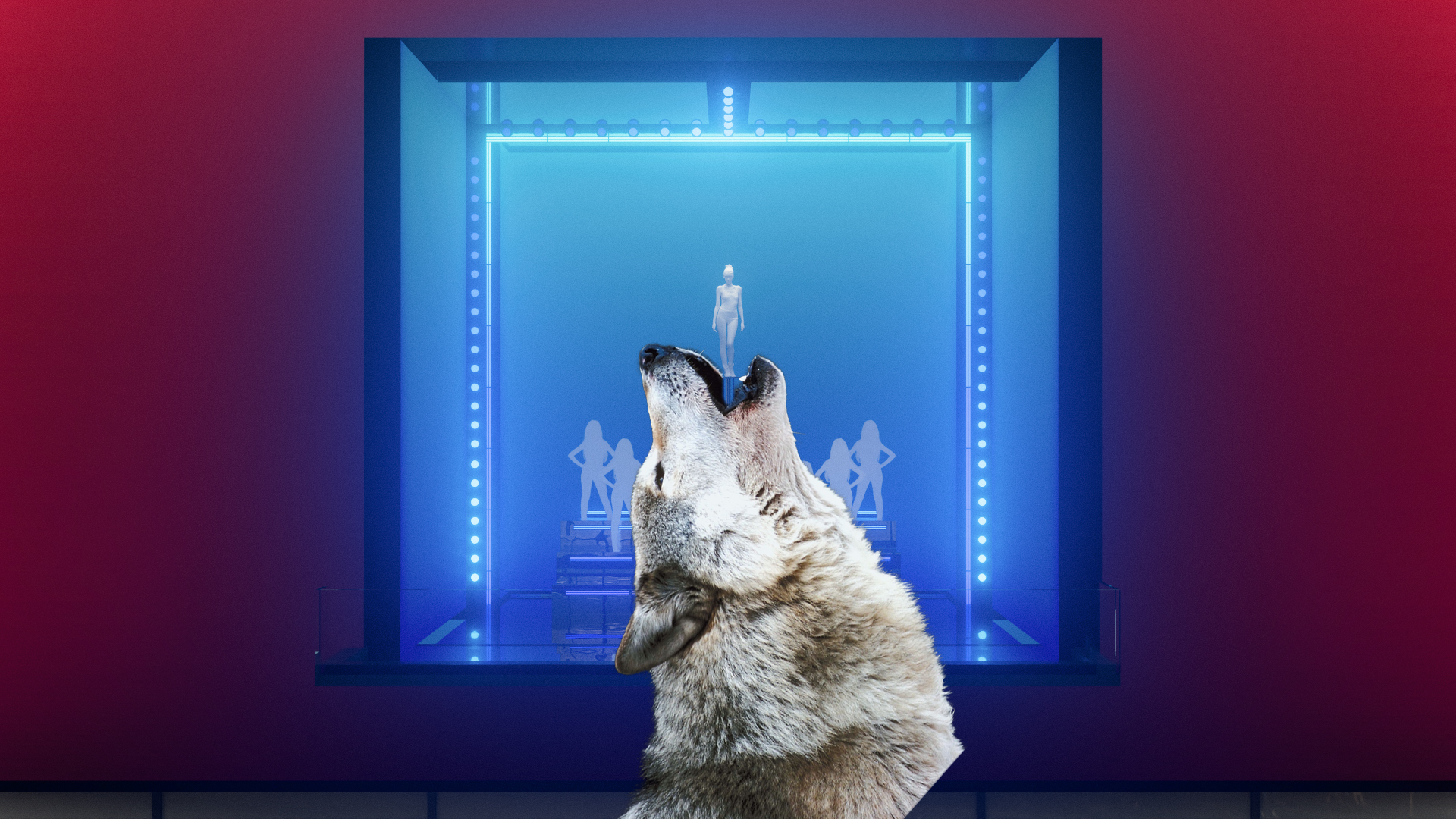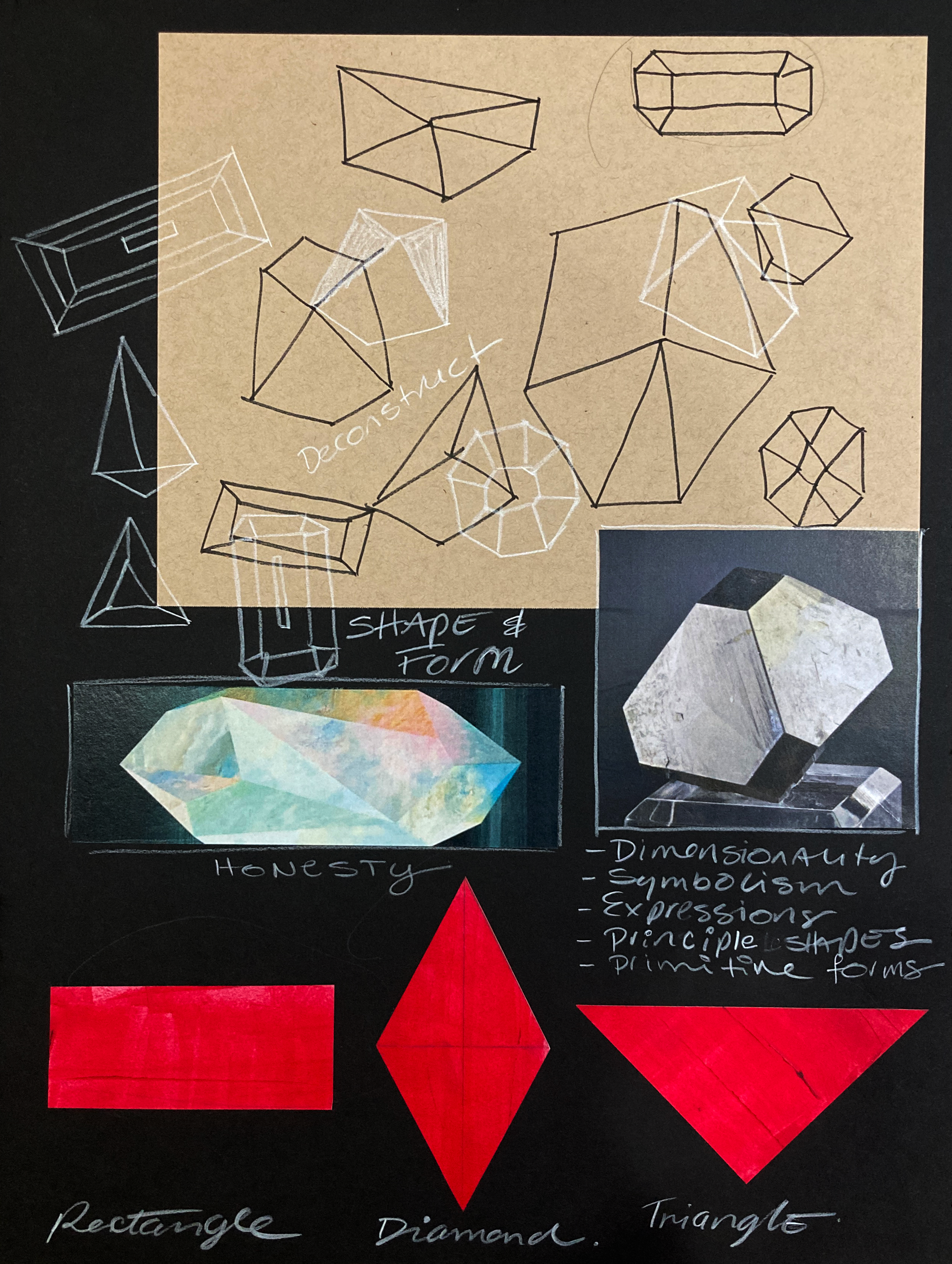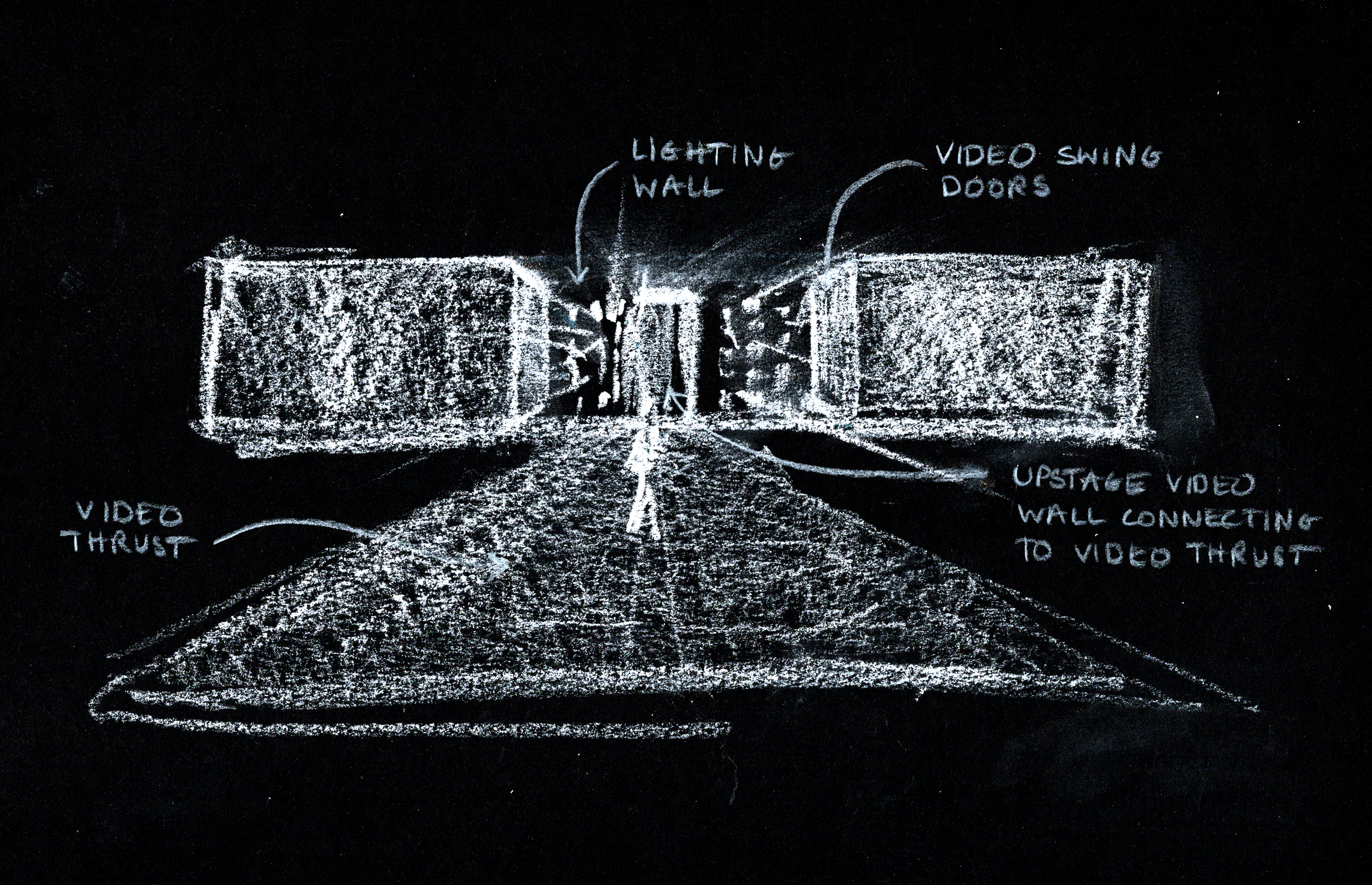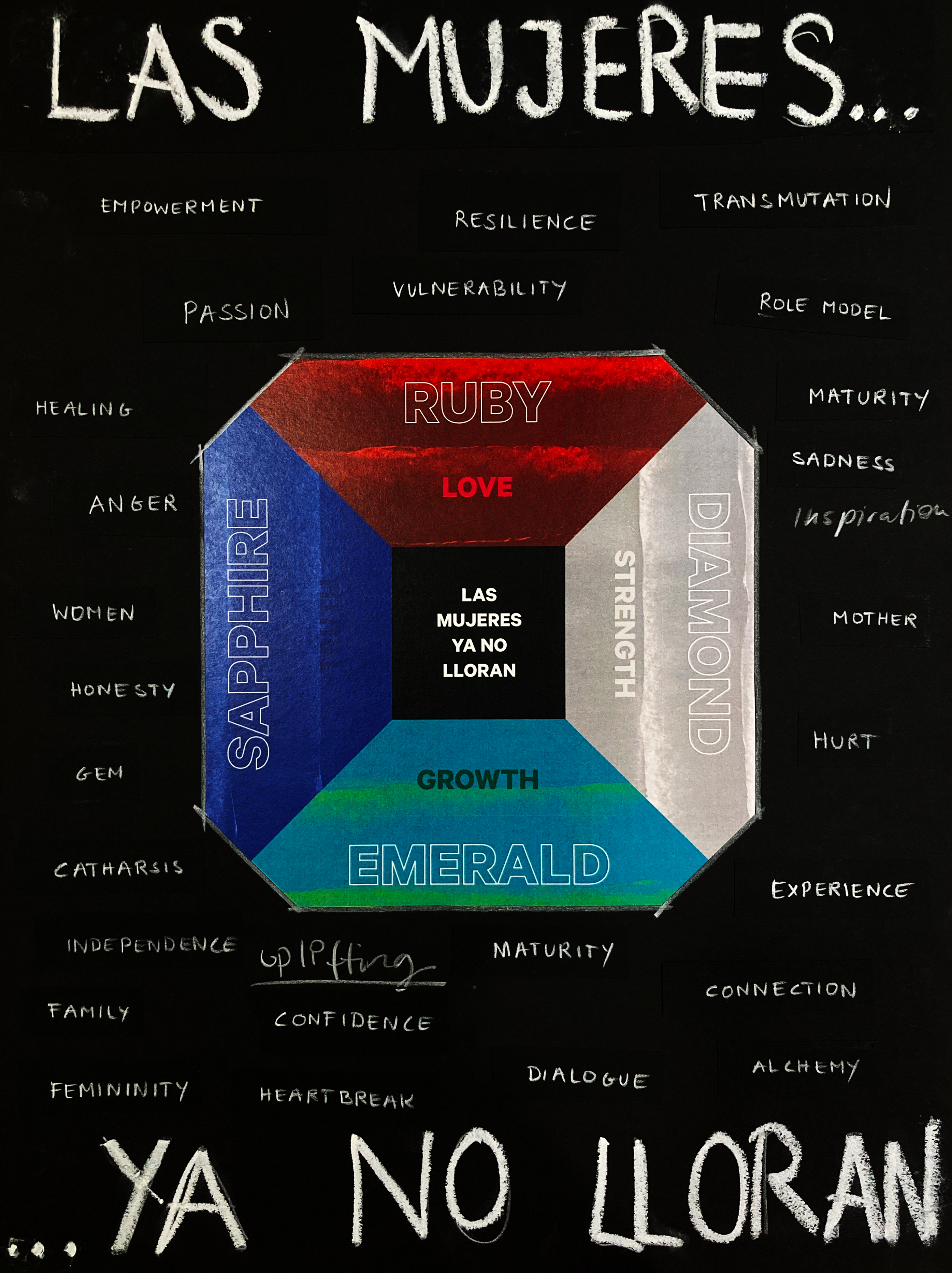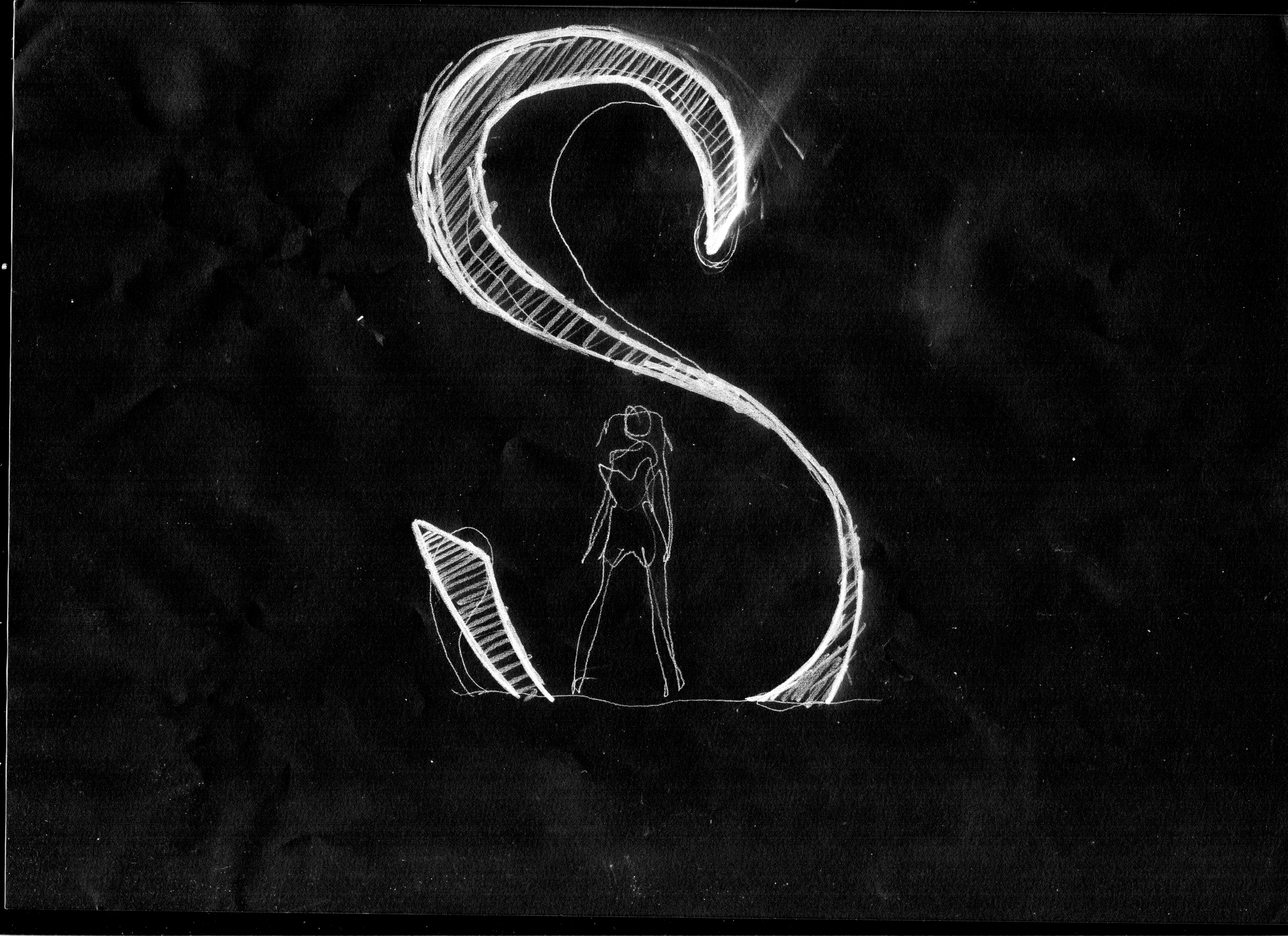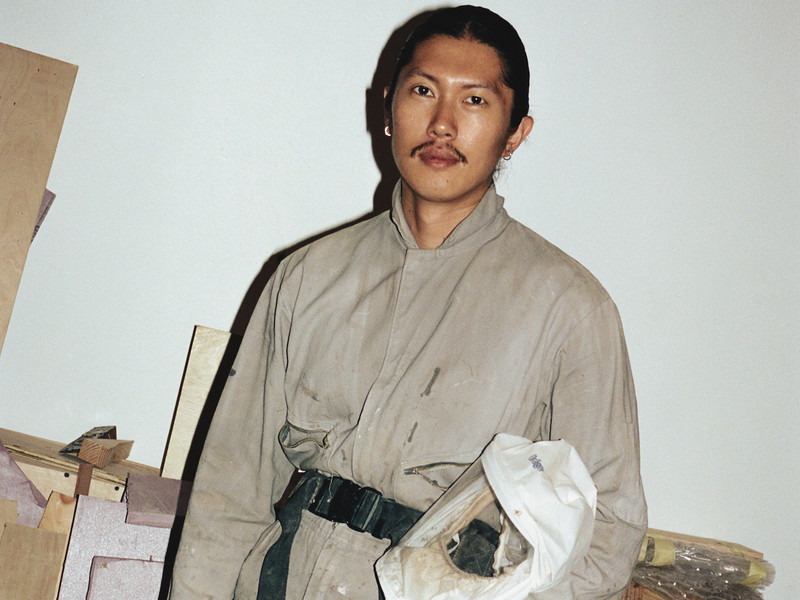Fire in the Sky: Cai Guo-Qiang
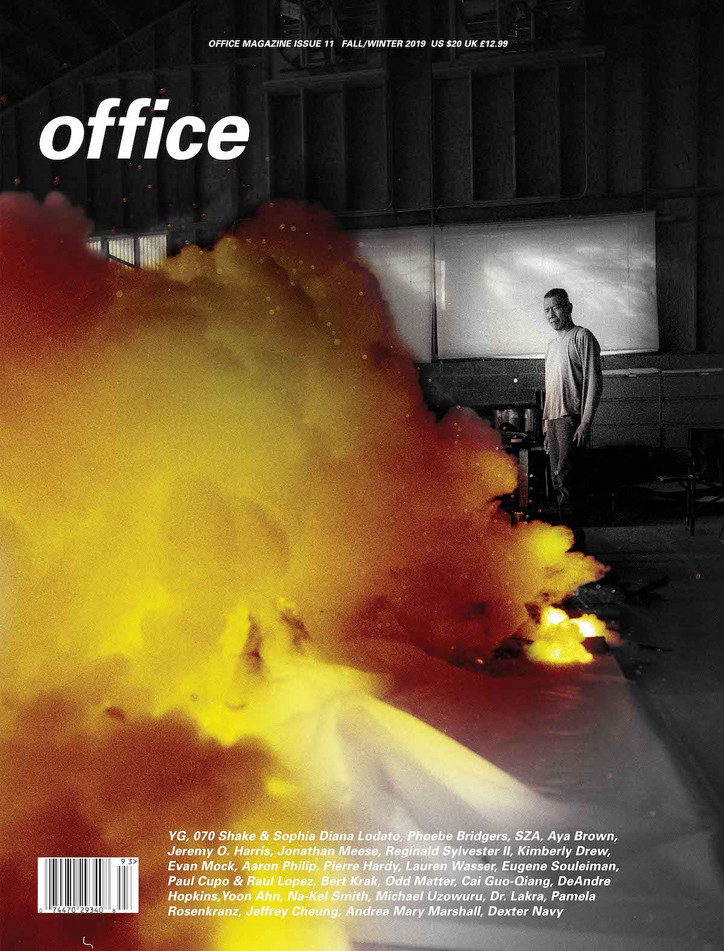
Gunpowder has dichotomous significance in Cai’s practice—on one hand, it honors the incendiary material’s rich history in his native culture, yet on the other, the medium’s entropic nature enables a departure from the highly methodical, precise crafts perfected by Cai’s artistic forebears in China. Explosive agents appear in his work in many forms—arranged on floor-mounted canvases and set on fire, their sooty byproducts depicting figures and shapes in a ghostly afterimage; positioned across landscapes and urban expanses, snaking through space as they detonate in sequence; combined with powdered dyes, equipped with timed triggers, and shot up into the daylit sky, bursting in colorful synchronicity.
For the extravagant opening ceremony of the 2008 Summer Olympics in Beijing, Cai set off giant firework footprints that paced through the air from Tiananmen Square to the Bird’s Nest National Stadium. In a work that serves as the backbone for the documentary film Sky Ladder: The Art of Cai Guo-qiang, he suspended a 550-yard ladder of cord traced with pyrotechnics from a helium balloon and ignited the base, sending fire crackling up the rails and across the rungs of the structure as it extended skyward, a glowing bridge between earthly and celestial realms.
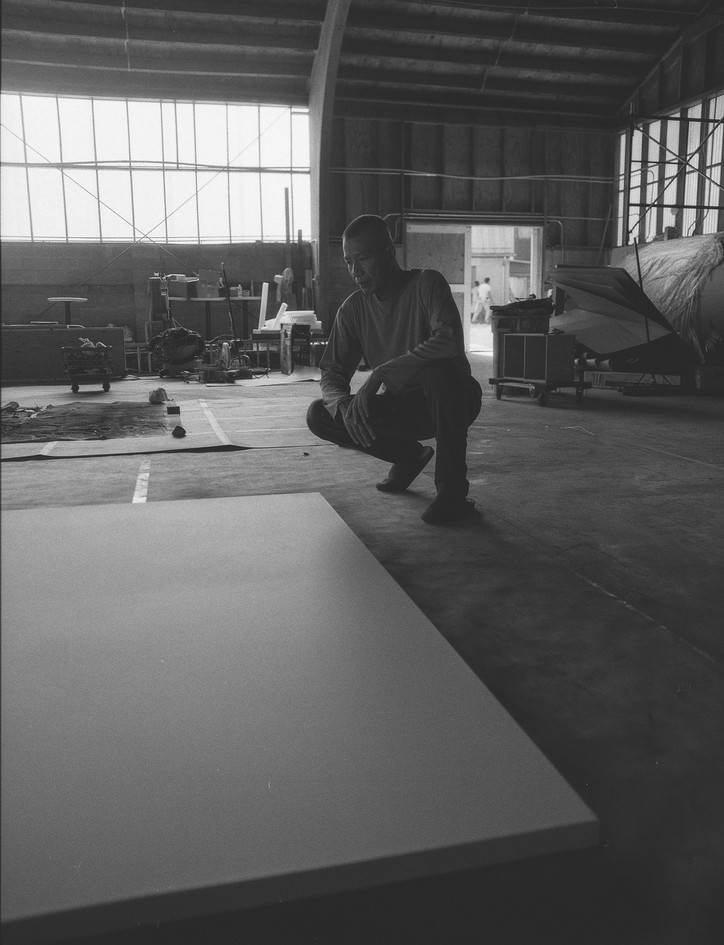

But despite the kinetic grandeur of his art, Cai has an aura of tranquility and grace about him that seems to radiate through his circle and his surroundings. When I arrived at his East Village studio, a dozen or so staff members were quietly at work in various corners of the complex. After missing the doorbell and loitering awkwardly in the entryway for a moment, I was warmly greeted by Cai’s wife, who sweetly apologized for my mistake. I was then handed off for a brief tour of the space, a beautifully renovated portion of a 19th century schoolhouse that now houses rooms for meditation, art storage and media viewing, a library, and a full kitchen and banquet area.
The artist then joined us as we all convened for the traditional Chinese lunch that is prepared daily for the studio staff. Over steaming dishes of duck, yams, and greens in broth, Cai held court, somehow managing to engage every member of the meal with kind attention. By the time he and I finally adjourned for our conversation, a deep, resonant calm had swept through me, and I felt fully absorbed into the collective mood of the place. We sat at a vast wooden table, sipped tea, and spoke through a translator about the origins of Cai’s practice, the influential forces in his life, and the communion between the seen and unseen world.
OFFICE— You’re fascinated with extraterrestrial concepts, and space exploration. Is that something that interested you since you were young? And what inspired it, do you think?
Cai Guo-Qiang— There must be two reasons. One is I felt suppressed by the society I was in when I was little. Of course, now it’s opening up, but when I was little I felt suppressed. So I dreamed of somewhere in the far distance, and the farthest for me back then was space. The other reason might be that my hometown is very attentive to feng shui and folk beliefs. So the gods, the ghosts and spirits— the ancient beliefs of my ancestors in my hometown, they all relate to something about the unseen world. The unseen world, in a sense, is also the immense universe. We know that only 5% of the universe can be seen, can be proved, while dark matter, and dark energy, they account for around 95% of the universe. Probably our ancestors just exist in that dimension, among this matter and energy, for our mythologies. When I grew up and then started my artistic career, I’d been thinking about whether art is essentially tangible. It is essentially tangible, but can we use tangible art to portray the unseen world?
O—Do you feel a connection to more traditional art forms, the sort of thing you may have seen as a child in China, versus more what’s referred to as contemporary art, which can be more experimental, less representative, less figurative?
CGQ—I feel I resonate a lot with the ceremony, the ritual side of it, when it comes to tradition. For example, in feng shui, people care about orientation and the flow of energy and usage of light, and which orientation can make you feel more comfortable and lucky, and you exist in that configuration. This is related to aesthetics. For lots of ceremonies and rituals, colors and shapes and forms play an important role, and they often try to just express the color, convey the color in the form of the folk art. Even for the symbols of the Tao, like the yin and the yang symbol, but more than just yin and yang. Taoism has a variety of symbols. If a kid gets sick in the middle of the night, he gets surprised and afraid, then there is a symbol in Taoism that can help cure such kind of symptoms. Of course then the Taoists really used red ink paste to draw that kind of symbol on yellowish, very rough paper. Then the Taoist practitioner would burn that yellow paper with the ink, the red symbol on it, and then ask the kids to drink water with the burnt paper. For me, it was like if you eat this piece of artwork, you will get cured.
O—Like edible medicinal art.
CGQ—Technically it also works, I feel, because this red ink paint in Chinese medicine contains certain elements that really can calm your spirit. So those kids who got scared in the middle of the night and cried, they may even really be cured by this kind of paste.
O—Right, not just psychologically, but physically.
CGQ—Yeah. So rituals and ceremonies like these, they influenced me a lot in my upbringing. And also my art, including what you saw, like those daytime fireworks. On the one hand, it’s related to the unseen world, and then also all the religious rituals. It’s also channeled to the universe, I feel, because part of the universe is unseen, but at a certain point, you sort of feel it—and then it’s gone. For me, it’s back and forth. It comes and goes. That’s what the universe, with its aspect of tangibleness, means to me.
O—So even though your medium may be regarded as very contemporary, when you look at something like these red ink drawings being burned there’s actually very traditional elements to what you are doing. It’s modern and ancient.
CGQ— Yeah. Those traditional methods influenced me and the contemporary artworks that I’m making. Of course, in some of my artworks, I indeed occasionally burn Chinese medicine, and then create and serve some sort of elixir based on Chinese medicine to the visitors of my exhibition, for them to enjoy at my galleries. But most important is to not turn the ritual into my art directly, whether or not the ritual and its implications and significance served as a foundation for my artistic method and artworks.
O—You mentioned feeling restricted by your society as a child. That’s definitely a stereotype that Americans assign to China, where we think the government and the culture limits what you can think, what you can say, what you can do. I’m curious to hear some of the details of how that manifested in your childhood. How did you become aware of those limitations? How were you aware that a less limiting society might exist elsewhere?
CGQ—I was around nine, in the first or second grade in primary school, when the Cultural Revolution broke out. I was one of those who criticized our teachers, even if I was only nine. We did it so hard that my teacher ended up not coming to the school anymore. We also broke all the glass panels of the windows in my school. Also, for a whole year, we didn’t go to classes. There was no class. There was even a slogan that was just, “No classes. Only revolution.” Something like that.
That year I had plenty of time to participate in lots of social activities, like riots on the streets, and also painted of course, because I had all the time to myself. So I get to do whatever I want to. I go swimming or go fishing and painting.
The whole country had only one newspaper. Of course we had some other dailies, but they all repeated the same content. As a result, when I was very little, I started to eavesdrop on the radio stations from abroad and from outside China. I buried myself in the blankets in bed and just secretly looked for the channels of the radio stations from abroad. Just one kilometer away from my hometown, there were lots of signal towers. The goal of them is to disrupt the channels of our enemies’ radio stations, but I could still somehow find some channel. So I felt suppressed by society, but that resulted in my strong desire to disrupt all these restrictions.
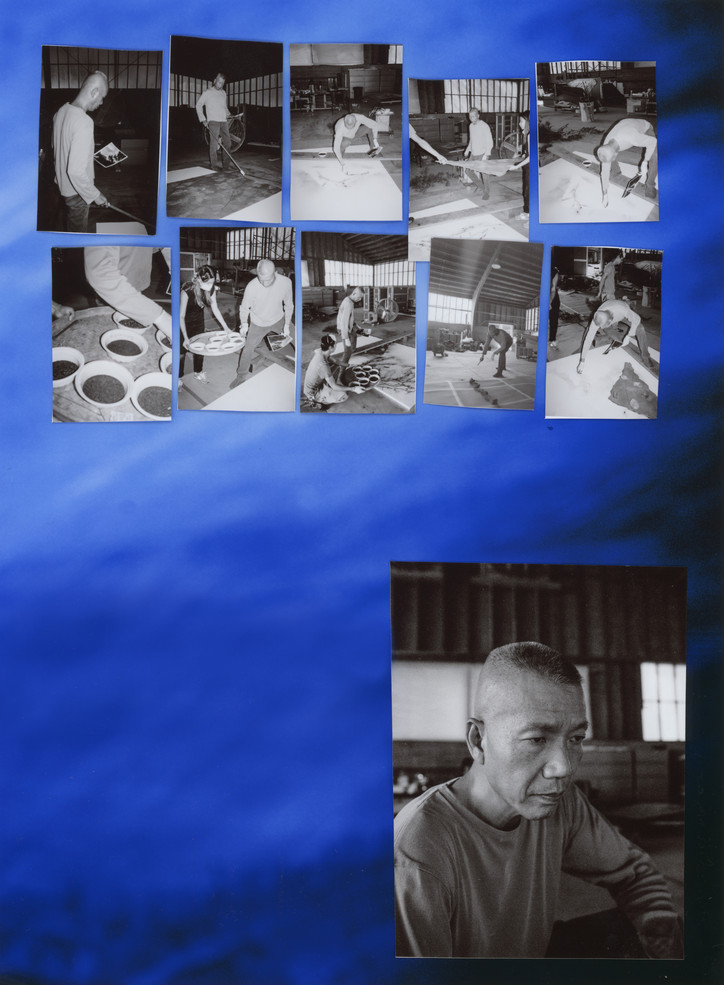
O—That radio also seems to represent, again, the unseen world.
CGQ—In a sense, which made you believe truly that the US and the Soviet Union really exist. All these experiences made me believe that they do exist. All those radio stations, even outside China, they speak perfect Chinese. I still remember that the radio station of the Soviet Union, they would say, in perfect Chinese, and also in a very familiar style and an intimate kind of voice, something like, “This is the Moscow Radio Station.” But in perfect Chinese.
O—Was there any punishment for all this rebellion? Breaking windows, chasing away teachers?
CGQ—There was not really any punishment for rebelling against a teacher or going into the streets, no. No punishment. After the Cultural Revolution, the government apologized to all those who had suffered unfairly. My teacher for example, who was dispelled from the school, very likely got all her salaries back after the revolution.
O—I mentioned the stereotypes that many Americans had and still have of China—I’m curious what the Chinese stereotypes of America were, what the view of America was in your childhood and as you grew. Were there individual figures who inspired you or who defined America for you at that time?
CGQ—A longtime Chinese stereotype of the US is that of a highly militarized country, a symbol of imperialism. Very corrupt. The films we saw about America were mostly about American soldiers. They ate meat off the bones, like beasts, like monsters, and they ate canned food. That’s what we saw about American soldiers in the films. America also meant satellites, going to the moon. We saw lots of news in China. It wasn’t real news. From news like this, when we were little, we understood how great our country was. Then we started to suspect our own gover nment. Then at the end of the ‘70s, Chair man Mao passed away, and then more and more American people traveled to China as tourists. Well naturally, in the beginning, we were thinking, “Whoa, all these American tourists. It must be all those capitalists,” as portrayed in our textbooks. But then very soon we realized you’re actually just like us, students, or just civil servants, or teachers. That was another shock for the young Chinese generation back then. Very soon, there were lots and lots of Chinese translations of American books about American society and politics and culture and economy and everything, which was a very groundbreaking experience for us to learn, to have a fresh impression of America.
O—Were there any books in particular that you read that you remember?
CGQ—I almost forget their names, but definitely Carl Sagan, a book by Carl Sagan about the universe. It’s one of those books that really impacted the Chinese, and especially me.
O—Interesting. Yeah, again, I find it so kind of fitting or significant this Chinese space exploration milestone from just yesterday. It’s just a big, I think, quite a big moment for China and for the world.
CGQ—In a sense, America, the US has been like a model for the Chinese.
O—I know that this moment yesterday for Xi Jinping was very validating, because he has very vocally supported the space program there. So he’s proud.
CGQ—Lots of Chinese nowadays, they’re constantly reminding people that we have to be more humble, because indeed, there is a very large gap between China and the US. We cannot only just look at the GDPs, not just a matter of GDP. In China, almost everybody hopes to study in the US, because the US enjoys such a high level of education. It’s a very established education system, and also very open.
O—Well, we hope to keep it very open moving forward.
CGQ—Of course. I have to be very cautious when I’m taking this interview, because seriously, I cannot represent the whole China as a country. Because I’ve been living in New York for decades. 23 years.
O—Well, I won’t ask you to represent contemporary China, but good to know the old. I know your family is clearly very important to you—from seeing you interact with your grandmother in Sky Ladder or hearing you speak about learning artistic techniques from your father. You said there were no real repercussions for your rebellion, in terms of government or society. But what were your parents’ views at the time? Did they have expectations of you that you were straying from, or were they supportive of you claiming your free time for your own and acting out against the school?
CGQ—My father was a sort of timid and cautious person. I actually helped my father burn lots of his books, but I know that he secretly kept part of his book collection in the countryside. But my grandmother was very bold. Yes. Back then, everybody was against capitalism, and the free market. My grandmother was a typical example of a free market because she herself sold fish in the market, and every day she’d just earn money by herself. She was living proof that she could make a living by herself and not rely on the government. She always secretly practiced feudalism, going to pay tribute at the temples, stuff like that. Or for major festivals, if traditionally we were required to pay tributes to the gods, then she would do that, even if it was forbidden back then. I often helped her by, for example, lowering the basket of fruits as tributes for the gods into the well, because then the gods can still enjoy it, but nobody will see it.
O—So one day you’re burning the books with your father, the next day you’re lowering the offering of fruit.
CGQ—If my father knew that those offerings were for the gods, then he wouldn’t eat it, because publicly he was a Communist Party member.
O—Do you remember some of the first connections you made to explosions? For example, in America, on the Fourth of July, as you know, we experience the noise and sight of explosions as something very celebratory, but also indirectly invoking war, “bombs bursting in air.” And on Chinese New Year, exploding firecrackers are used to dispel bad spirits, things like that. Do you remember your early experiences of explosions?
CGQ—In Quanzhou, my hometown, the noise of explosions came not only from firecrackers, but also from the explosion of the rocks in the mountain to help excavate stone. Because the buildings were made of the stone exploded from the mountain. So sometimes the whole city would know there was an explosion of stones in the mountain happening, because the whole city sort of just shook for that second. In China, for a long, long period, fireworks only took place on, say, the National Day ceremony, celebrations in Tiananmen Square in Beijing. For the rest of China, and on other occasions, it was mostly just firecrackers. But even with the firecrackers, still it was very loud, of course, especially for the New Year. All the cities would be submerged in the noise of the firecrackers.
O—There’s an excitement around the noise and the vision, but is there also a sense of fear?
CGQ—For me, yes. I feared the firecrackers a lot when I was little. My grandma had to hold my hand to light the firecrackers. In my hometown, even for a funeral, there normally is a ceremony, and then this whole group of people will go a long way before they reach the cemetery. Along the way, whenever they pass a village, there should be firecrackers in order to dispel the evil spirits. It is also to inform the passed one that now it’s time to cross a bridge, now it’s time to pass a village.
O—When did you first realize you had the opportunity to depart from China?
CGQ—In the early ‘80s, people in China started to go abroad on their own, because before then they really relied on the national stipends. But then things started to change. So I first went to college in Shanghai, and then I started to get ready to go abroad. I was lucky enough to get to know an acquaintance who, at the time, was working in the Palace Museum in Beijing. He has lots of connections with the Japanese end, and arranged my study in Japan. Once I landed in the Japanese airport, there was a very strong smell that I can still vividly remember today, which is perfume and the smell of the tires of the cars. Because back then in China, there weren’t that many automobiles. I remember I landed on December the 13th, and very soon it was Christmas Day. I never experienced Christmas Day before then. It was such a lively and festive occasion for the whole city. Christmas trees and lights, everybody perfectly dressed. But I felt very lonely.
O—In Japan, it sounds like you had some struggles with the prog ress of your ar tistic career. You’ve spoken about galleries passing on your works, and you really having to persist. Was there a particular breakthrough moment for you while in Japan?
CGQ—In the beginning, I thought Japan was a capitalist country and a very democratic country. I thought I could do whatever I want. Then once I was really there, I went to this park in Japan where there are lots of museums and exhibitions. I realized that those museums and exhibitions, they all looked very much the same as their counterparts in China, which are just very realistic style. So I was very disappointed. I thought I could just do whatever I want in Japan, but the reality was different. It was not easy in the beginning to access gunpowder in Japan. While in my hometown in China, though we couldn’t do whatever we wanted for the exhibitions and artworks, gunpowder was everywhere.
O—So was America then the combination where you could do whatever you want, and we’ve got tons of gunpowder?
CGQ—No. In the US, you need a permit for the purchase and transportation of gunpowder. It’s very problematic in the US as well. Of course, contemporary art in the US was mainstream already, while for Japan back then, traditional art was still the mainstream. But in the ‘90s, contemporary art in Japan started to boom very fast. Lots of emerging museums started exhibiting contemporary art, and lots of private museums as well. So more and more contemporary art came into being, just like China today.
O—As you continued to make art, and it became clear you were making contemporary art that was not very well represented in China, were you in communication with people back home? What were their reactions to your art? Were you gaining attention or was it still too strange?
CGQ—When I was in China, I was not that close to my artist peers. Nor was I one of the official artists, who often have official exhibitions expedited. For those official artists, they had national government salaries and stipends, but of course they had to paint per the requirements of the government. But I was also not part of any school. For those school artists, they often used art as a tool to express their political agenda, and I was not part of them either. They were intentionally rebellious against the government. For me, I was just myself, very individual. I was not against or for the system. In Japan, of course, I came to know artists who were more like me, artists who hoped to make a living, but with their own power and capacity. This is very different from China. The mentality that you have to make a living and to survive in the society and even to support your family with your own hands, with paint, this is a very different mentality than those Chinese artists.
O—What was it that eventually drew you to the United States, and why New York?
CGQ—In Japan, bit by bit, I became a star artist who was loved by everyone. But in my Japan period, most of my exhibitions happened in Europe, not in the US. I knew back then that almost the whole world is thinking about the US, including its art market and art museums and galleries and artists and their schools, the emerging schools in the US. And Matthew Barney came on stage in the ‘90s, and Bruce Nauman. So for me, I felt it would be the right decision to go to America and to live there. Instead of living in Japan, and then only doing exhibitions in Europe, and then back to Japan. No, that’s not the lifestyle I envisioned. Since the whole world is talking about the US, then why don’t I just live in the US and do exhibitions around the world?
O—Was it your first time, or had you exhibited here or visited as a tourist?
CGQ—I had only come here once before then, to see the Grand Canyon. I visited New York once on the same trip. It was a great experience. So then I was more determined to try to move to New York. The Asian Cultural Council expressed a desire to help me, but back then the Japanese side said that Cai is not Japanese, so he cannot come to the US as a Japanese representative and receive this grant. So I waited a few years, and started having exhibitions in various places in the world as a Japanese representative, as a Japanese artist.
O—To sort of prove a track record in representing Japan?
CGQ—Yeah. Also the Tokyo Museum of Contemporary Art had just opened, in Japan, and held an exhibition entitled Art in Japan Today: 1985-1995. The biggest artwork in the exhibition was mine. Perfect proof. So the ACC approached the Japanese side again, and they decided it should not be a problem for Cai to come to the US as a Japanese representative. I came that year.
O—How did you adapt? Did you have a family yet?
CGQ—Yeah, I got married in Japan and had my first daughter, and then we moved to the US together. When I first arrived in the US, I felt I was back to when I first arrived in Japan. But more specifically, when I first arrived in Japan, I felt I went back to the past of China. When I was first in the US, I felt I was in the future of China.
O—In both cases, you felt isolated or alone?
CGQ—Indeed. I feel I have been lonely and isolated. I’m just like a super meteor. And also a nomad.
O—But is that something that ultimately you enjoy, and that helps you in your artistic practice?
CGQ— Yeah. For artists, they often complain that they’re lonely, but they also enjoy being lonely.
O—Do you feel that your art provides a way for you to share yourself, and engage with people in a way that perhaps you don’t in an everyday context?
CGQ—Indeed. I feel art constitutes my isolated world, but it’s also a time-space channel for me. It allows me to come into my own world and then go outside of it to mess up a little bit, or to start something up and then come back to myself again. Through my art, I socialize with people and then get into the communities and engage them. But at the end of the day, I still come back to myself, my own art world, and back to the lonely state. In a sense, this time- space channel allowed me to go between the east and the west, between the art and the heart, and see an unseen world.
O—You’ve spoken about 9/11 as a significant experience for you personally, living in New York. Do you think sharing the pain of the city and the culture bonded you to it?
CGQ—Before September 11, my mentality was very much the same as what I had in Japan, which was that I was a guest here. But after September 11, I felt I belong here. Also, after September 11, I feel my artwork started to be more rooted to this ground. I started to have solo exhibitions at MASS MoCA and then the Met, and the Guggenheim, partly because my artworks had become engaged in more dialogues with the local culture. In a sense, I changed after September 11, regarding this country as my own place, regarding this culture as part of my own culture. My artworks, and then hence their subjects and content also changed as a result of it.
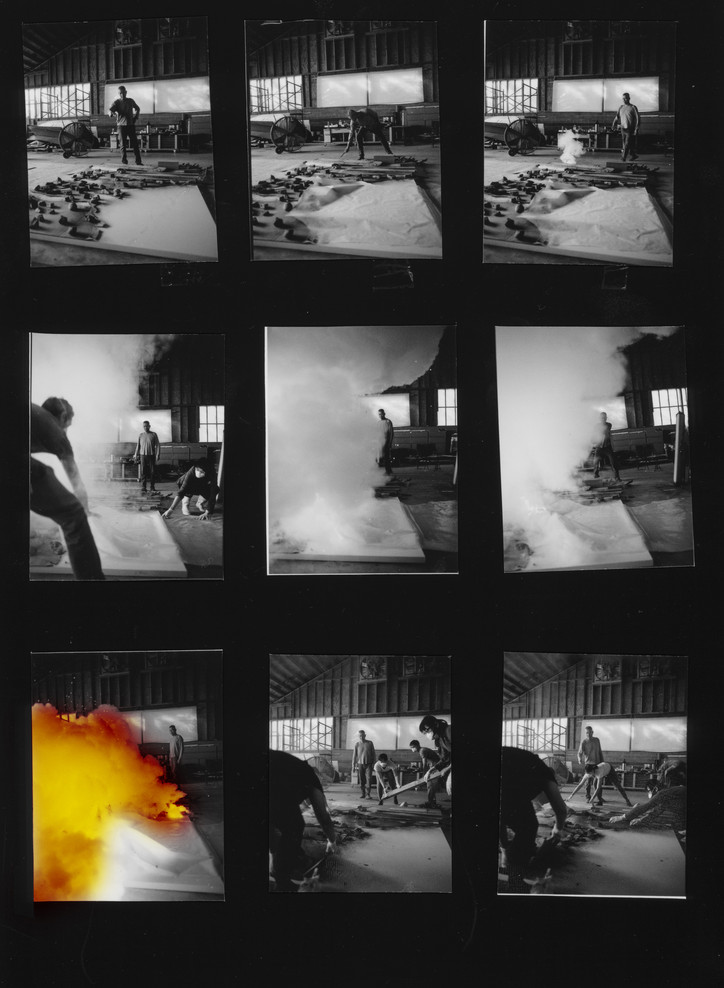
O—Now, having some space between you and that event, and having more than a decade under your belt as feeling native, in a way, or feeling welcome and accepted and part of the culture here in New York and in the United States, what direction is your art taking at this point in your career?
CGQ—I feel American art has been more and more conservative, and its politics too. There has been a tremendous change in the world, but still, what brought along those fundamental changes to the world have still been coming from the US. So in this sense, the US, America is still incredible. But on the other hand, the world is expressing changes at an accelerating speed, in China just the same. Compared to this accelerating speed, for me America is more and more conservative.
So my two recent major projects deal with two main themes. One is art history. The other is the cosmos. My cosmos-related projects include, for example, an upcoming project in Mexico, that will coincide with the arrival of the Spaniards there 500 years ago. So that’s about the cosmos. Then regarding art history, that’s another theme. I’m not content with the fact that as contemporary artists, we just bury our heads within the realm of contemporary art and the contemporary art game itself, dealing with art markets and the system. Rather, I think we should go beyond this all the way to the Asian, Greek, and Roman civilizations, the Renaissance, and medieval period, and so on, and then reflect on why we make art. Hopefully from there, we can regain the pleasure of making art and regain our impulse and sort of artistic sensibility. I hope to regain the spirit and the desire and the passion of art. Through this exploration, we can face the question of new possibilities in art in this digital age, and then big data, and artificial intelligence.
O—I know you’ve experimented with, for example, chips in the fireworks that allow them to be synchronized. Are you excited by technology and what it can do for your art?
CGQ—Yeah, indeed. Thanks to technology, can we start to dream things like whether we can insert computer chips in firework shells in order to create a firework that could symbolically commemorate September 11th, which I did with the Transient Rainbow, the explosion event off the East River. One year after September 11th, no fireworks were allowed in the US, because everyone felt it was not the right moment to do fireworks. Then MoMA commissioned me to do something, so together, we managed to convince the mayor of New York to do a fireworks event with Transient Rainbow, to demonstrate that new life is happening.
O—And to become comfortable with the explosion again, comfortable with the noise and the sight.
CGQ—Indeed. After that, more and more, fireworks started to come back into our lives. So, you asked whether and how I will continue using technology in my art. I feel technology can not only help realize, say, letter fireworks in the sky, not only that. More importantly, I can rely on technology to develop fireworks to be less toxic, and with little smoke, that could be fully reabsorbed. With the help of the various institutions and governments that I work with to create my fireworks, I try to engage scientists and technical experts to develop environmentally friendly fireworks. Then I hope that other people will also create environmentally friendly fireworks, and that will be a beneficial thing for the whole world and influence the whole industry.
O—A piece of art was recently launched into space from California, which will visibly orbit the earth for a short period of time. It’s relatively simple, but it’s touted as one of the first human-made art pieces to go beyond the bounds of the earth. Does it interest you at all, to see your art in space?
CGQ—I’ve realized lots of cosmos-related artworks, and I’ve attempted to realize cosmos art projects, but most of them didn’t materialize. I started doing that in the ‘80s. For example, one of my attempted proposals was—well, you know we have pyramids on the earth? My idea was to dig a negative pyramid on the moon. Crazy weird ideas like that. Lots and lots of ideas.
Since the late ‘80s until now, almost three decades, I’ve had wild ideas about the universe. Lots of people, even some traditional Chinese artists, have sent their works into the universe before this California artist. Even some artists in Japan. They all made use of their national satellites to carry their artwork into the universe. So yeah, these are all acceptable. These are okay, but the most important thing is why mankind has to think about universe, reflect on the universe. Does the universe provide a good opportunity for more scientists to win Nobel Prizes, for example? Or can we say the universe is a museum? Ultimately, we have an internal emotional attachment to the universe. Can we say that the universe is our ultimate hometown? Is it only a space to which we can send an artwork to get hyped about in the news? More importantly, it’s about us constantly dreaming, thinking about whether another living species exists there. And then doing something, creating something. It provides an opportunity for us to think bigger. —END
